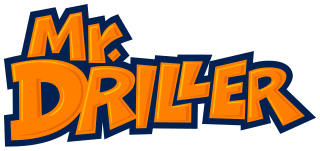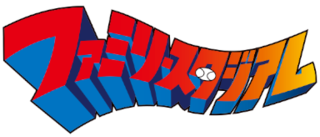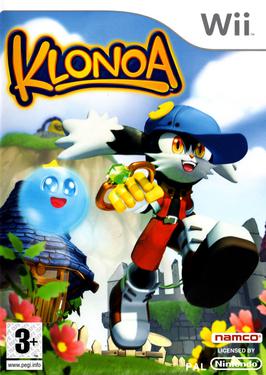Related Research Articles

Mr. Driller is a puzzle video game franchise created by Yasuhito Nagaoka and Hideo Yoshizawa for Namco. The eponymous first game was released in 1999 for arcades and several home consoles, such as the PlayStation. Gameplay in the series consists of controlling Susumu Hori, the titular Mr. Driller, or one of his friends and destroying colorful formations of blocks to make it to the bottom of a well. In order to survive, players need to collect air capsules to replenish their depleting oxygen and avoid being crushed by falling blocks.

Klonoa is a platform video game series created by Namco in 1997. It stars Klonoa, an anthropomorphic creature who explores dream worlds. The series includes two main games: Klonoa: Door to Phantomile (1997) for the PlayStation and Klonoa 2: Lunatea's Veil (2001) for the PlayStation 2. A remake of Door to Phantomile was released for the Wii in 2008, and remasters of both games were released in 2022. The series also includes a set of handheld games released between 1999 and 2002 for the WonderSwan and Game Boy Advance.
1991 saw many sequels and prequels in video games, such as Street Fighter II, Final Fantasy IV, Super Castlevania IV, Mega Man 4, Super Ghouls 'n Ghosts, and The Legend of Zelda: A Link to the Past, along with new titles such as Sonic the Hedgehog, Battletoads, Lemmings, Sunset Riders, Duke Nukem, Fatal Fury: King of Fighters, and Streets of Rage. The year's highest-grossing video game worldwide was Capcom's arcade fighting game Street Fighter II. The year's best-selling system was the Game Boy for the second year in a row, while the year's best-selling home video game was Sega's Sonic the Hedgehog, which was also the year's top video game rental in the United States.

Klonoa 2: Lunatea's Veil is a platform game developed and published by Namco for the PlayStation 2 in 2001. It is the direct sequel to Klonoa: Door to Phantomile (1997) for the PlayStation.

Mr. Driller Drill Spirits is a 2004 puzzle video game developed and published by Namco for the Nintendo DS. Controlling one of six characters, the player must make it to the bottom of each stage by destroying, colored formations of blocks while preventing their oxygen meter from depleting. Multiple different gamemodes are present, including a single-player campaign, a time-attack mode, and a competitive multiplayer mode. It is the sixth entry in the Mr. Driller series.

Klonoa: Empire of Dreams is a 2001 platform video game published by Namco for the Game Boy Advance. Falling somewhere between Klonoa: Door to Phantomile and Klonoa 2: Lunatea's Veil, Empire of Dreams is a two-dimensional adventure game with puzzle elements that takes place in the new realm in the Klonoa series, the Empire of Jillius.

Klonoa: Moonlight Museum is a video game developed by Namco and published by Bandai, released in Japan for the WonderSwan in 1999. It is the first handheld game in the Klonoa series to place him in a fully two-dimensional world, and established the system that the Game Boy Advance titles later used.

Klonoa: Door to Phantomile is a platform game developed and published by Namco for the PlayStation in 1997 and the first game in the Klonoa series. The story follows Klonoa and his friend Huepow in their efforts to save the dream world of Phantomile from an evil spirit intent on turning it into a world of nightmares. The player controls Klonoa through a 2.5D perspective; the stages are rendered in three dimensions but the player moves along a 2D path. Klonoa can grab enemies and throw them as projectiles, or use them as a jump boost to navigate through the stages.

Pac-In-Time is a platform game developed by Kalisto and published by Namco, featuring the arcade character Pac-Man. It was released in 1995 for MS-DOS, Macintosh, Super Nintendo Entertainment System, and Game Boy.

Famista 64, also known as Family Stadium 64, is a 1997 baseball video game developed and published in Japan by Namco for the Nintendo 64. Controlling one of fourteen selectable teams, both real-world and fictional, the player must score more runs than the opposing team by pitching, batting and catching the ball, as in real baseball. It is the twelfth entry in the Family Stadium series, serving as a 3D remake of the original Pro Baseball: Family Stadium.

Family Stadium, also known as Pro Yakyū: Family Stadium and Famista, is a series of baseball sports video games initially developed and released by Namco in Japan, and later developed and published by Bandai Namco Entertainment. The first entry in the series, Pro Baseball: Family Stadium, was released for the Nintendo Family Computer in 1986 and later in North America as R.B.I. Baseball, with the series being released on numerous home consoles, the latest being Pro Yakyuu Famista 2020 in 2020 for the Nintendo Switch. The series is considered a precursor to Namco's own World Stadium series of baseball games, released for arcades, PlayStation, and GameCube. The series has been a commercial success since, with over 15 million copies being sold as of 2016.
Hideo Yoshizawa born September 2, 1960, is a Japanese video game director, screenwriter, and producer, most famous for his work on the Ninja Gaiden and Klonoa series of video games. Prior to being employed by Namco, he worked for Tecmo and was involved in the original Ninja Gaiden trilogy for the Nintendo Entertainment System under the name "Sakurazaki".

We Ski is a 2008 skiing video game for the Wii developed and published by Namco Bandai Games. It is the first third-party game released that makes use of the Wii Balance Board.

Klonoa is a side-scrolling platform video game for the Wii developed by Paon and published by Namco Bandai Games. It is a remake of the 1997 PlayStation game Klonoa: Door to Phantomile, the first game in the Klonoa series, updating the game with fully 3D graphics, additional content, and gameplay changes. It was released in Japan in December 2008 and in North America and Europe in May 2009.

Mr. Driller is a 1999 puzzle arcade game developed and published by Namco. Versions for the PlayStation, Dreamcast, Microsoft Windows, Game Boy Color, WonderSwan Color, mobile phones, and iOS were also released. Controlling Susumu Hori, the titular "Mr. Driller", the player must dig their way to the bottom of the screen by destroying colored blocks that litter the playfield. Blocks will be cleared if four or more are touching each other, which can be used to cause chain reactions. Susumu has a constantly-depleting oxygen meter that can be refilled by collecting air capsules found throughout stages.

Mr. Driller G is a 2001 puzzle arcade game developed and released in Japan by Namco for its System 10 hardware. It is the third installment in its Mr. Driller series, and the last released for arcades. Controlling one of seven characters, players must make it to the bottom of the level by destroying colorful formations of blocks. G introduces several new ideas to the series, such as power-ups, a story campaign, and online multiplayer.

Namcot Collection, also known as Namco Museum Archives, is a 2020 video game compilation published by Bandai Namco Entertainment. Originally released in Japan for the Nintendo Switch, it was localized for international territories as two separate collections, Namco Museum Archives Vol. 1 and Vol. 2, for the Switch, Xbox One, PlayStation 4, and Windows. Namcot Collection includes a wide array of video games published by Namco for the Family Computer and Nintendo Entertainment System, with save states, achievements, and homebrew ports of Pac-Man Championship Edition and Gaplus.

Mr. Driller A is a 2002 puzzle video game developed and published in Japan by Namco for the Game Boy Advance. The fourth installment in its Mr. Driller series, players control one of seven characters and must make it to the bottom of the level by destroying colorful formations of blocks. A adds several new mechanics to the gameplay of its predecessors, such as a virtual pet named the "Pacteria" that players can grow and care for.

Klonoa Phantasy Reverie Series is a 2022 Klonoa video game compilation developed by Monkey Craft and published by Bandai Namco Entertainment. It features remasters of the platform games Klonoa: Door to Phantomile (1997), originally released on PlayStation, and Klonoa 2: Lunatea's Veil (2001), originally released on PlayStation 2. The remaster of Door to Phantomile is built from its 2008 Wii remake developed by Paon.
References
- 1 2 "スーパーファミリーテニス (SFC)". Famitsu . Kadokawa Corporation. Archived from the original on 3 February 2020. Retrieved 3 February 2020.
- 1 2 Parish, Jeremy (17 September 2012). "Champion of Dreams: An Interview with Hideo Yoshizawa". 1UP.com . IGN. Archived from the original on 3 November 2012. Retrieved 3 February 2020.
- ↑ "スイッチでスーパーファミコンソフトが遊べるように。まさかの名作も復活!". Dengeki Online. 5 September 2019. Archived from the original on 2 December 2019. Retrieved 4 February 2020.
- ↑ "Testscreen: Super Family Tennis". No. 1. Future Publishing. Edge. October 1993. p. 87. Retrieved 3 February 2020.
- ↑ Stephan; Martin (September 1993). "Test Super Nintendo - Super Family Tennis" (in German). Mega Fun. pp. 92–93. Archived from the original on 4 February 2020. Retrieved 4 February 2020.
- ↑ "Top 100 SNES Games". Total! (43): 42. July 1995.